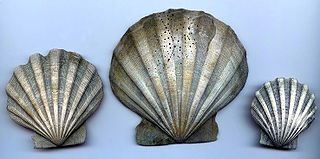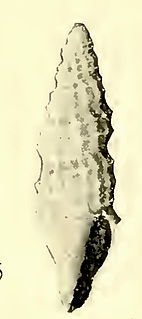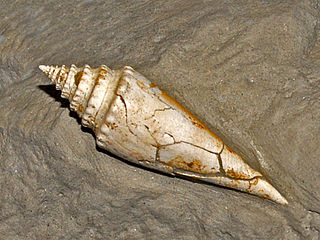
Chesapecten is an extinct genus of scallop known from marine strata from the early Miocene to the early Pleistocene of the Eastern United States.

Sinistrofulgur perversum, the lightning whelk, is an edible species of very large predatory sea snail or whelk, a marine gastropod mollusc in the family Busyconidae, the busycon whelks. This species has a left-handed or sinistral shell. It eats mostly bivalves.
Ivara is a small genus of sea snails, pyramidellid gastropod mollusks or micromollusks. This genus is currently placed in the tribe Chrysallidini, of the family Odostomiidae. The Brazilian species have been revised by Pimenta et al. (2009). There are both living and fossil species in this genus.

Hystrivasum horridum, common name the rough or shaggy vase, is a fossil species of medium-sized predatory gastropod in the family Turbinellidae. This species is extinct and is found in the Pleistocene deposits of Florida.

Conus luciae is a species of sea snail, a marine gastropod mollusk in the family Conidae, the cone snails and their allies.

Conus pergrandis, common name the grand cone, is a species of sea snail, a marine gastropod mollusk in the family Conidae, the cone snails and their allies.

+ Agathotoma candidissima, common name Cox's mangelia, is a species of sea snail, a marine gastropod mollusc in the family Mangeliidae.
Lissodrillia simpsoni, common name Simpson's drillia, is a species of sea snail, a marine gastropod mollusk in the family Drilliidae.

Glyptaesopus is a genus of sea snails, marine gastropod mollusks in the family Borsoniidae
Emily Hoskins Vokes is an American malacologist, palaeontologist, and former university professor. She is an authority on the Muricidae, a large and diverse family of predatory sea snails, or marine gastropod mollusks. Vokes worked both on her own and with her husband, geologist Harold Ernest Vokes.

Kelletia is a genus of large sea snails, whelks, a marine gastropod molluscs in the family Buccinidae, the true whelks.

Conilithes is an extinct genus of sea snails, marine gastropod mollusks in the family Conidae, the cone snails.

Conus anningae is an extinct species of sea snail, a marine gastropod mollusk in the family Conidae, the cone snails, cone shells or cones.
Conus miamiensis is an extinct species of sea snail, a marine gastropod mollusk in the family Conidae, the cone snails, cone shells or cones.
Conus paranobilis is an extinct species of sea snail, a marine gastropod mollusk in the family Conidae, the cone snails, cone shells or cones.

Glyptaesopus oldroydi is a species of sea snail, a marine gastropod mollusk in the family Borsoniidae.
Kyllinia parentalis is an extinct species of sea snail, a marine gastropod mollusk in the family Mangeliidae.
Contraconus is an extinct genus of sea snails, marine gastropod mollusks in the family Conidae.
Conasprella burckhardti is an extinct species of sea snail, a marine gastropod mollusk in the family Conidae, the cone snails and their allies.
Eoconus sauridens is an extinct species of sea snail, a marine gastropod mollusk, in the family Conidae.













